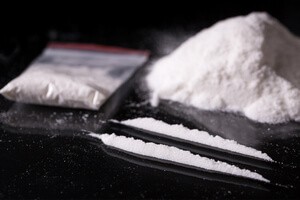Cocaine, an infamous stimulant, is widely recognized as a white powder frequently mixed with substances like talcum powder or cornstarch to increase bulk and profitability. Alarmingly, it can also be combined with other stimulants or potent synthetic opioids such as fentanyl, dramatically elevating the risk of overdose. Users typically snort cocaine, although it can also be smoked or dissolved for injection. Understanding the process of how cocaine is made is crucial to grasping the complexities of its illicit trade and harmful effects.
 Close up detail of white powder drug
Close up detail of white powder drug
The journey of cocaine from plant to powder is a multi-stage chemical process, primarily originating from the leaves of the coca plant, native to South America. This intricate process, often carried out in clandestine labs, transforms the coca leaf into cocaine hydrochloride, the powdered form commonly sold on the streets. Let’s break down the main steps involved in cocaine production:
From Coca Leaf to Coca Paste: The Initial Extraction
The process begins in regions where coca plants are cultivated. The first step is harvesting coca leaves, which contain relatively low concentrations of cocaine alkaloids. Large quantities of leaves are required to produce even small amounts of cocaine.
-
Coca Leaf Harvesting and Preparation: Mature coca leaves are harvested, often multiple times a year. These leaves are then typically chopped or shredded to increase their surface area for the subsequent extraction process.
-
Solvent Extraction (Maceration): The chopped coca leaves are soaked in solvents, traditionally kerosene or gasoline, in large pits or containers. These organic solvents extract the cocaine alkaloids from the plant material. Other chemicals like sulfuric acid or cement may be added to enhance the extraction process and neutralize impurities. This mixture is agitated, often by people stomping on the leaves and solvent mixture, to maximize alkaloid extraction.
-
Separation and Filtration: After soaking, the liquid containing the dissolved cocaine alkaloids is separated from the coca leaf debris. This is often done through filtration, which can be as rudimentary as using cloth to strain the liquid.
-
Coca Paste Formation: The extracted liquid is then treated with more chemicals, typically sulfuric acid and then ammonia or cement/lime, to precipitate the cocaine alkaloids out of the solvent. This process results in a thick, pasty substance known as coca paste. Coca paste is not cocaine hydrochloride; it is an intermediate product containing a mixture of cocaine alkaloids, residual solvents, and other impurities. It typically contains around 40-90% cocaine base.
Refining Coca Paste into Cocaine Base
Coca paste is further processed to increase the purity of cocaine. This stage aims to remove more impurities and convert the mixture into cocaine base.
-
Oxidation: Coca paste is dissolved in sulfuric acid and then potassium permanganate is added. This oxidation process removes many of the remaining impurities from the coca paste.
-
Separation and Washing: The mixture is then filtered again, and the solid residue is washed with water to remove residual permanganate and other byproducts of the oxidation.
-
Ammonia Treatment: Ammonia is added to the purified solution to precipitate the cocaine base. This base is a purer form of cocaine but is still not the hydrochloride salt. Cocaine base is the form typically smoked (“crack cocaine”).
Conversion to Cocaine Hydrochloride: The Final Powder
The final step in producing powdered cocaine, the form most commonly encountered, is converting the cocaine base into cocaine hydrochloride.
-
Dissolving Cocaine Base: The cocaine base is dissolved in a solvent, often acetone or ether.
-
Hydrochloric Acid Addition: Hydrochloric acid is added to this solution. This acid reacts with the cocaine base in a process called salt formation, resulting in the precipitation of cocaine hydrochloride crystals.
-
Crystallization, Filtration, and Drying: The cocaine hydrochloride precipitates out of the solution as a solid. This solid is then filtered and dried, often using heat lamps or microwaves, to remove any remaining solvents and moisture. The resulting product is powdered cocaine, or cocaine hydrochloride, ready for distribution and sale.
Dangers and Realities of Cocaine Production
The process of making cocaine is not only complex but also extremely dangerous and environmentally damaging. Clandestine labs often operate with little regard for safety or environmental regulations.
- Hazardous Chemicals: The use of flammable solvents like kerosene and ether, corrosive acids like sulfuric acid and hydrochloric acid, and toxic chemicals like potassium permanganate poses significant risks of explosions, fires, and chemical burns for those involved in the production.
- Environmental Damage: Large quantities of toxic waste are generated during cocaine production, including leftover solvents, acids, and other chemicals. These are often dumped indiscriminately into the environment, polluting soil and water sources, devastating ecosystems, and harming local communities.
- Health Risks in Production: Individuals involved in cocaine production, often coerced or working in exploitative conditions, are exposed to harmful chemicals, increasing their risk of respiratory problems, skin diseases, and other serious health issues.
Conclusion
The production of cocaine is a hazardous, multi-step chemical process that transforms coca leaves into the white powder known on the streets. From the initial extraction in crude jungle labs to the final crystallization into cocaine hydrochloride, each stage involves dangerous chemicals and processes with severe consequences for both people and the environment. Understanding how cocaine is made sheds light on the destructive nature of the illicit drug trade and the profound risks associated with this substance.